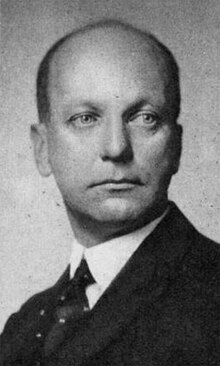Giles Gilbert Scott
| Sir Giles Gilbert Scott | |
|---|---|

Scott in 1924 at the time of the consecration of Liverpool Cathedral
|
|
| Born |
9 November 1880 Hampstead, Middlesex, England |
| Died | 8 February 1960 (aged 79) Bloomsbury, Greater London, England |
| Nationality | United Kingdom |
| Alma mater | Beaumont College |
| Occupation | Architect |
| Buildings | Battersea Power Station, Liverpool Cathedral, House of Commons |
Sir Giles Gilbert Scott OM RA (9 November 1880 – 8 February 1960) was an English architect known for his work on such structures as Liverpool Cathedral, Waterloo Bridge and Battersea Power Station and designing the iconic red telephone box. Scott came from a family of architects. He was noted for his blending of Gothic tradition with modernism, making what might otherwise have been functionally-designed buildings into popular landmarks.
Born in Hampstead, London, Scott was one of six children and the third son of George Gilbert Scott Jr. and his wife, Ellen King Samson. His father was an architect, the son of Sir George Gilbert Scott, a more famous architect, known for designing the Albert Memorial and the Midland Grand Hotel at St Pancras Station.
When Scott was three, his father was declared to be of unsound mind and was temporarily confined to the Bethlem Royal Hospital. Consequently, his sons saw little of him. Giles later said that he remembered seeing his father only twice. A bequest from an uncle in 1889 gave the young Scott ownership of Hollis Street Farm, near Ninfield, Sussex, with a life tenancy to his mother. During the week Ellen Scott and her three sons lived in a flat in Battersea, spending weekends and holidays at the farm. She regularly took them on bicycling trips to sketch buildings in the area, and encouraged them to take an interest in architecture. Among the buildings the young Scott drew were Battle Abbey, Brede Place and Etchingham Church; Scott's son, Richard Gilbert Scott, suggests that the last, with its solid central tower, "was perhaps the germ of Liverpool Cathedral".
...
Wikipedia
